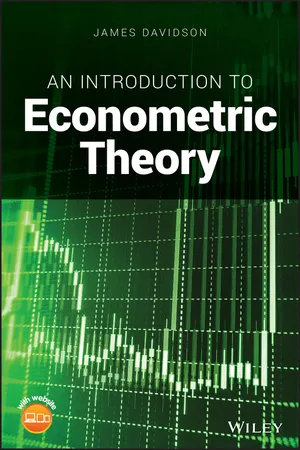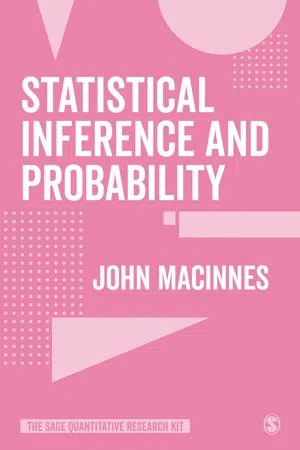Geometric Distribution
The geometric distribution is a probability distribution that models the number of trials needed to achieve the first success in a series of independent Bernoulli trials, where each trial has a constant probability of success. It is characterized by a single parameter, the probability of success on each trial, and is often used in scenarios such as modeling the number of attempts before a successful outcome.
6 Key excerpts on "Geometric Distribution"
- eBook - ePub
Statistical Methods for Geography
A Student's Guide
- Peter A. Rogerson(Author)
- 2019(Publication Date)
- SAGE Publications Ltd(Publisher)
...If the statistics class was large (i.e., the survey was repeated a large number of times), the sample variance and theoretical variance would be very similar. We see that an attractive feature of specifying processes and distributions is that they have particular characteristics – we can say something about the mean and variance without actually seeing the data. Just as the shape of the histogram gives us visual information about the likelihood of particular outcomes, the theoretical mean and variance give us numerical information summarizing the expected outcomes. Example 3.1 The annual probability of flooding in a community is 0.25. What is the probability of three floods in the next four years? Solution: In this case, each year represents an independent trial. Each trial results in either a success (a year with flooding, though flooding is hardly considered a success), or a failure (a year without flooding). The probability of ‘success’ in each year is equal to p = 0.25. The probability of X = 3 successes in n = 4 years is: (3.5) 3.4 The Geometric Distribution The binomial distribution is used when there are n independent trials, when there are two possible outcomes on each trial, and where the probability of success is constant and equal to p on each trial. The discrete random variable of interest is the number of successes that occur. In some cases, however, we are interested in other characteristics of this same process. For example, we may be interested in how long it takes to observe the first ‘success’. Suppose that an individual has a constant probability of moving in each year. The probability that the individual’s next move is during the coming year is p ; the likelihood that they move next in the second year of observation is (1 − p) p (since we observe that they do not move in year 1, and they do move in year 2). We may generalize further: the probability that the next move occurs in year 3 is (1 − p)(1 − p) p, or (1 − p) 2 p...
- eBook - ePub
Introductory Probability and Statistics
Applications for Forestry and Natural Sciences (Revised Edition)
- Robert Kozak, Antal Kozak, Christina Staudhammer, Susan Watts(Authors)
- 2019(Publication Date)
- CAB International(Publisher)
...As in binomial experiments, the probability of failure is q = 1 – p. The probability function of the Geometric Distribution is defined by only one parameter p, as: Example 5.12. A bag contains several thousand white pine seeds, 10% of which are empty. What is the probability of finding the first empty seed the fifth time we cut a seed open? An extension of the Geometric Distribution occurs when trials are repeated until a fixed number of successes, k, occurs. Such a random experiment is called a negative binomial experiment and its probabilities are described by the negative binomial distribution. Like a geometric experiment, a negative binomial experiment possesses all the properties of a binomial experiment except that the number of trials is not fixed. The negative binomial random variable, X, represents the number of independent trials required to produce k successes, where p is the probability of success and q = 1 – p is the probability of failure. In developing a general equation, consider that to obtain the k th success on the x th trial, the k th success must be preceded by k – 1 successes and x – k failures. The probability of k – 1 successes and x – k failures can be arranged in the following number of ways: The probability of p k q x–k is multiplied by the number of possible arrangements 2 to obtain the probability of the k th success. The general form of the negative binomial probability distribution function is: The parameters p and k define the negative binomial distribution. Note that, when k = 1, the above equation reduces to the Geometric Distribution because the number of arrangements of one success preceded by x – 1 failures is simply 1. In other words, the Geometric Distribution can be said to be a special case (where k = 1) of the negative binomial distribution. Example 5.13. Consider the white pine seeds described in Example 5.12...
- eBook - ePub
- James Davidson(Author)
- 2018(Publication Date)
- Wiley(Publisher)
...One feels that such factors could in principle be understood and, with sufficient data, be predicted exactly, so that nothing is really ‘random’. However, as a practical matter this cannot be done, and the best that can be done is to distinguish more and less probable outcomes, where here ‘probable’ is understood to refer to the accumulated experience of previous outcomes. Probability theory, and especially what is called distribution theory, uses mathematical formulae to describe such patterns of randomness and also to generate predictions of future outcomes. As a first approach to understanding the pattern in Figure 5.1, try counting the incidence of hits in different regions of the target. Figure 5.2 shows a smoothed representation of the data, in which the regions of the plane with similar frequencies of hits have been connected by lines. The result is similar in appearance to a physical contour map, in which points of equal height above sea level are joined up with lines. A probability distribution is a mathematical model of a phenomenon such as target shooting, and the contour mapping idea is rather close to the way that frequencies of occurrence are handled mathematically. A formula called a probability density function (p.d.f. for short) quantifies, for each point of the target, the historical frequency of strikes in that region. As has long been known, a mathematical formula that does jobs of this type with good accuracy is the normal curve, or normal ‘surface’ in the bivariate case, also called the Gaussian curve since an early proponent was the famous nineteenth century German mathematician C. F. Gauss. 1 The bivariate normal probability density function is shown as a three‐dimensional image in Figure 5.3...
- George V Chilingar, Leonid F. Khilyuk, Herman H. Reike(Authors)
- 2012(Publication Date)
- Gulf Publishing Company(Publisher)
...There are k consecutive choices for the birth dates of k people. Each choice can be made in 365 different ways. The total number n of possible ways for the k birth dates (the total numbers of possible outcomes) is The number n B can be calculated as the number of permutations of 365 elements taken k at a time (refer to Appendix 2): The resulting formulas for the probability P (B) are given by equations or If k = 23, then P (B) = 0.493, and P (A) = 1 − 0.493 = 0.507. This number represents the probability of occurrence of two or more earthquakes on the same day (if 23 quakes occurred during the year), as well as the probability that two or more participants of a soccer match (including referee) share the same birth date. GEOMETRIC DEFINITION OF PROBABILITY Let us suppose that G is some domain in the Euclidean space of any finite dimension (line, plane, etc.). Consider a stochastic experiment that consists in random choice of a point from the domain G. Assume that for any A ⊂ G the probability of event “the chosen point belongs to A” does not depend on location inside G and is proportional to the measure of A. How can one define the probability that a point randomly chosen from domain G belongs to region A ? First of all, one needs to compose a probabilistic space that matches this experiment. For that purpose, it is possible to consider the set of all points from G as Ω and the collection of subsets of G having a measure in the primary Euclidean space as ϕ. The probability P (A) to choose a point inside A is completely determined by the stated conditions. Namely, according to our conditions P (A) = C μ(A), where μ(A) is the measure of A, and C is a proportionality coefficient. In particular, P (G) = P (Ω) = C μ(G) = 1 is the probability of sure event. Therefore, C = 1/μ(G). Taking this value for C, one yields: (4.12) Equation 4.12 is called the geometric definition of probability...
- eBook - ePub
Statistics in Psychology
An Historical Perspective
- Michael Cowles(Author)
- 2005(Publication Date)
- Psychology Press(Publisher)
...6 Distributions When Graunt and Halley and Quetelet made their inferences, they made them on the basis of their examination of frequency distributions. Tables, charts, and graphs – no matter how the information is displayed – all can be used to show a listing of data, or classifications of data, and their associated frequencies. These are frequency distributions. By extension, such depictions of the frequency of occurrence of observations can be used to assess the expectation of particular values, or classes of values, occurring in the future. Real frequency distributions can then be used as probability distributions. In general, however, the probability distributions that are familiar to the users of statistical techniques are theoretical distributions, abstractions based on a mathematical rule, that match, or approximate, distributions of events in the real world. When bodies of data are described, it is the graph and the chart that are used. But the theoretical distributions of statistics and probability theory are described by the mathematical rules or functions that define the relationships between data, both real and hypothetical, and their expected frequencies or probabilities. Over the last 300 years or so, the characteristics of a great many theoretical distributions, all of which have been found to have some practical utility in one situation or another, have been examined. The following discussion is limited to three distributions that are familiar to users of basic statistics in psychology. An account of some fundamental sampling distributions is given later. The Binomial Distribution In the years 1665–1666, when Isaac Newton was 23 and had just earned his degree, his Cambridge college (Trinity) was closed because of the plague. Newton went home to Woolsthorpe in Lincolnshire and began, in peace and leisure, a scientific revolution...
- eBook - ePub
- John MacInnes(Author)
- 2022(Publication Date)
- SAGE Publications Ltd(Publisher)
...the arithmetic mean) and spread (e.g. their variance or standard deviation). Trials take one or more mutually exclusive outcomes, which are comprehensively described by their sample space. Bernoulli trials take only two outcomes. The probability distribution of a variable conditional upon the distribution of another variable describes their association. The linear association of two continuous variables described by the Pearson linear correlation coefficient r takes values from −1 to +1. The Gaussian, normal or bell-shaped probability distribution is one in which most observations are found near the mean and become less frequent as the distance from the mean increases. Further Reading Michael Blastland and David Spiegelhalter’s (2013) The Norm Chronicles, is an entertaining and accessible introduction to probability. As Winton Professor or Risk at the University of Cambridge, Spiegelhalter runs an excellent website about all things probabilistic (UnderstandingUncertainty.org). Ian Hacking’s The Taming of Chance (1990, Cambridge University Press) sets the development of the understanding of probability in its historical context....





